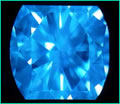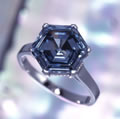 Natural blue color is one of the rarest of the colors in diamonds. They are among the most sought after by collectors. The colors can range from faint to a very deep blue. Some of them can command even higher prices than pink diamonds.
Natural blue color is one of the rarest of the colors in diamonds. They are among the most sought after by collectors. The colors can range from faint to a very deep blue. Some of them can command even higher prices than pink diamonds.
Common names for blue diamonds include navy, steel, sky, royal, zircon, baby and midnight. Rough blue diamonds are mined in South Africa, India and Australia.
 Boron atoms, even in smaller concentrations, cause blue color. Some rare gray – blues are caused by hydrogen. The secondary hues and modifiers are: gray, green and violet.
Boron atoms, even in smaller concentrations, cause blue color. Some rare gray – blues are caused by hydrogen. The secondary hues and modifiers are: gray, green and violet.
 The elements of boron may also be substituted within a diamond during its formation. Boron absorbs red light, hence in the absence of nitrogen, diamonds containing boron are blue in color. An example of a diamond containing boron is the famous Blue Hope diamond. Diamonds containing boron also exhibit unusual electrical properties and are semi-conductive in nature. Hydrogen is another impurity that, in high quantities, can cause grey or blue coloring in diamonds. However, these diamonds are not semi-conducting.
The elements of boron may also be substituted within a diamond during its formation. Boron absorbs red light, hence in the absence of nitrogen, diamonds containing boron are blue in color. An example of a diamond containing boron is the famous Blue Hope diamond. Diamonds containing boron also exhibit unusual electrical properties and are semi-conductive in nature. Hydrogen is another impurity that, in high quantities, can cause grey or blue coloring in diamonds. However, these diamonds are not semi-conducting.
India was the main producer of blue diamonds from 1500-1700. This was the source for the 112.25 French Blue that later became the the infamous 45.52 Hope. Another famous blue, the 33.56 Wittelsbach showed up at a wedding in 1667, and ended up in Bavaria in 1717 with the ruling House of Bavaria, the Wittelsbachs.
Today, any new production of blues comes from South Africa. In 1904 a 136.25 blue diamond was found in South Africa. In order to understand pricing, here are some examples of recent auction prices. In October, 1994, at Sotheby’s, a dealer representing a Hong Kong concern, paid $9 million, or over $460,000 per carat for a 20.17 blue diamond. In 1995 at Sotheby’s, a 6.70 blue diamond sold for $3.52 million, or $525,000 per carat.
 For some enhanced (irradiated) blue diamonds, the color closely resembles natural blue diamonds. However, most of the enhanced blue diamonds resemble natural teal blue diamonds. Natural type 2b Blue diamonds are electrically conductive and are easily identifiable due to this property. Enhanced blue diamonds are popular due to their relatively low price compared to their natural counterpart.
For some enhanced (irradiated) blue diamonds, the color closely resembles natural blue diamonds. However, most of the enhanced blue diamonds resemble natural teal blue diamonds. Natural type 2b Blue diamonds are electrically conductive and are easily identifiable due to this property. Enhanced blue diamonds are popular due to their relatively low price compared to their natural counterpart.
